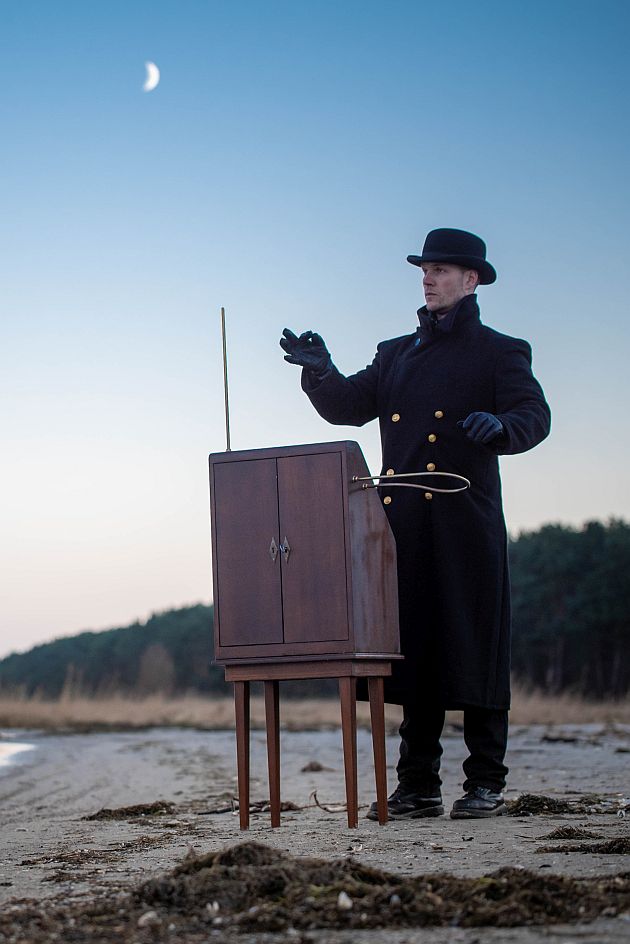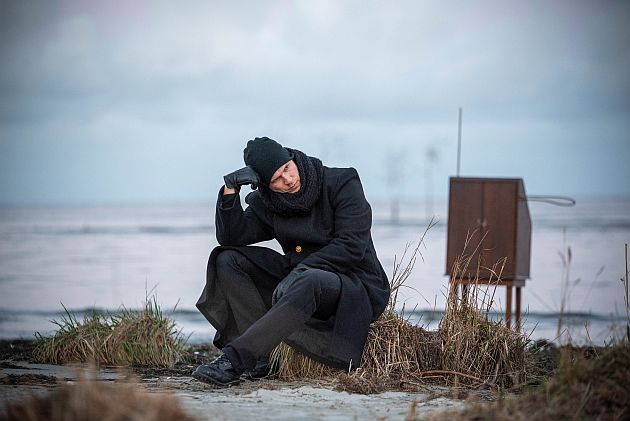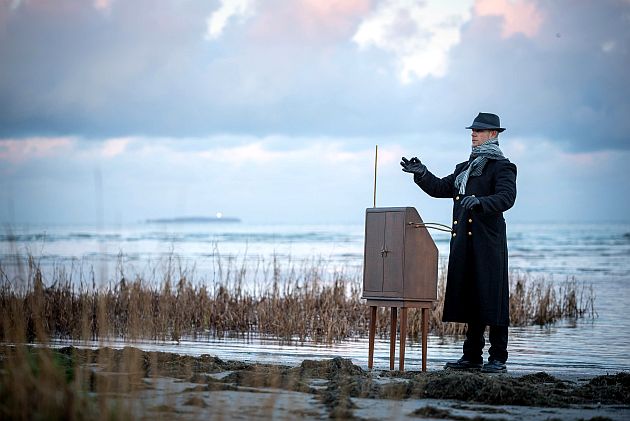 Interview with
Interview with Robert Meyer (singer, producer, thereminist) from Schramm
I first met SCHRAMM and their incredible energy (and looks) in Vienna during Schattenwelt Festival. They definitely have a lot of energy to offer and the performance they present is hard to forget. But Robert Meyer, the front man for the band, is not only about EBM, Gothic and Metal - his other side turns to a more subtle and sophisticated music side - he is a thereminist and a painter! About what’s so special about the theremin, but also about SCHRAMM history, paintings, dirt in art and dystopia…
Reflections of Darkness [RoD]: A singer, producer, thereminist… and a painter - which role do think has the most of you?
Robert: I think each of these areas of work represents equal parts of my artistic personality and flows together. Depending on the order situation, I am also more involved in one topic. When we have a lot of gigs with Schramm, I like to see myself as a frontman, otherwise, I primarily intend to be a thereminist. Painting is an area that I pursue evenly.
RoD: I have a feeling these days you’re more involved in theremin rather than SCHRAMM. Could you please tell me more about what fascinates you in the instrument, what is so special about it? I read you are even a member of the Theremin Society?
Robert: Even if I don’t post something all the time, I am always working on new SCHRAMM songs and lyrics. The appearance is reduced to a minimum by Corona. It also makes working on new songs more difficult. We usually test new songs several times in front of an audience and then continue working on them in the studio. The atmosphere of a show influences the arrangements as well. Our rehearsals are also very limited by lockdowns and quarantines. This impact and creative input that normally comes from the live events is currently completely absent. Lately, I have been able to perform quite often with my Theremin despite Corona. These are mostly classical concerts with piano accompaniment. The theremin that I’ve been using at SCHRAMM for five years is something like the fulfilment of my musical dreams. This instrument is highly sensitive and reflects every emotion of the player. Due to the invisible controls in the air, it evokes a great fascination in the audience. Often the audience is very touched by melancholy pieces and I see how some people wipe the tears from their eyes. The fact that I can convey such strong emotions with the Theremin is breath-taking for me. I have contact with thereminists all over the world. This also applies to Dorit Chrysler from the Theremin Society in New York. I am not a member of the Society but I cooperate with them closely. I initiated an international music sampler last year and published it for the 100th birthday of the Theremin.
RoD: I noticed when you perform with SCHRAMM you use lavish costumes, but when you do theremin concerts you usually put on a suit (apart from that recent concert in Zinnowitz when you were wearing a wig and a courtly getup)? Anyway - it’s a total contrast - where does it come from? Which side of you prevails?
Robert: The look at a concert plays a big role for me and I like to dress differently for different occasions. While the gloomy, energy-loaded show by SCHRAMM invites you to wear bizarre, tattered, end-time costumes with lots of make-up, a theremin concert is more of a classic thing. The thereminists of the 1930s came on stage stylishly dressed, all in tailcoats and suits. That is appropriate and fits with it. I deliver a demanding performance to classical, chanson or swing. That would be absurd in the SCHRAMM clothes. However, if I were invited to give a dark industrial solo theremin performance, I would probably fall back on the SCHRAMM clothing. In general, I love the clothing style of the 20s, 30s and 40s. Since my Theremin replica looks like a device from the 30s, I can accommodate it a little.

RoD: Whose idea was it to start SCHRAMM in the first place? What’s the idea behind your scenic looks? Do you find the visual aspect an important part of your performance?
Robert: In 2005 I produced the first Noise / Industrial tracks under the project name SCHRAMM, which were on a few web radios at the time. It wasn’t until 2010 when Ringo and I wanted to start something music-related together and we turned the studio project into a band. Since we move between the genre EBM, Metal, Industrial and Gothic, our style of clothing on stage is of course also quite dark and cliché. So, we said back then that we wanted to move towards something close to the old Mad Max films. There is just this archaic component that looks almost like war clothing of some native folks. But made from thrown, recycled materials and elements. Elements that have been taken out of their original purpose to create something completely new and dirty. Just like it happens with samples in music. We have already made many designs and tried a lot. We also sometimes swapped items of clothing with one another. Only one thing never worked: once we wanted to be more elegant. Then we suddenly had a bad feeling and found our concert photos boring.
RoD: I’m asking this because you are also involved in other sides of art. What will we find in Atelier-Galerie Robert Meyer? In what way music and visual arts intermingle in your mind to create music? What is the role of painting in your art?
Robert: Since I was a child, I have constantly followed painting and drawing. My little atelier-gallery in Zinnowitz is my platform, where I can constantly display my pictures and visitors can talk to me casually and look over my shoulder while I’m working. I always exhibit around 120 works there. Most of these are smaller collages. I really enjoy working on collages because I can create a story from snippets I find. Same with the clothes at SCHRAMM or with samples in a musical arrangement. My pictures have strong colours and lots of artefacts and tell stories that can be viewed from many angles. I can’t and don’t want to paint lovely and smooth, that doesn’t work. There must always be dirt and patina with it. This is reflected in all areas of my work. Even the theremin game lives from background noises and small disharmonies. Art should always have something improvised, natural, alive.
RoD: You not only give concerts as thereminist but also lectures. What’s your experience with people coming to your concerts?
Robert: Most people come to my concerts because they are curious and open. They may have seen the theremin on television or heard about it while listening to the soundtrack. People are excited to see how I work with the theremin and how I can come up with melodies. The short lectures I give during a concert are absolutely necessary. They not only make the program more entertaining and somewhat relaxing but also give the audience an important insight into the history, functioning and playing of the instrument. Some people who don’t know the theremin think I’m just conducting or humming the notes. After a concert, the audience comes to me to ask questions and see the theremin up close. Sometimes I also let someone try it out briefly. The audience that comes specifically to a concert is very pleasant and interested. Many of them tell me about their impressions and emotions after the show. What I think is nice is that the same people often return to my concerts now. They already know everything about the theremin and are no longer surprised, but just want to enjoy the performance. They just think it’s beautiful and want to follow my development. That’s a big compliment.
RoD: You were born in an artistic family - do you think upbringing among artists had an influence on you? What were other factors that brought you to music?
Robert: In any case, it had a big impact on my development. Music and painting were always present. My children’s room was right next to the painting studio and we were often at my father’s shows with his band. My interest was also aroused in the late 80s by radio, records and music broadcasts. My sister was older and there was always DEPECHE MODE and A-HA on the tape recorder. We tried to play ‘Personal Jesus’ on the guitar. But I was never forced to take music lessons. Many children are talented, but their interests are diminished or rejected. Parents who are into making music may recognize this better and can promote the talents of their kids. It even starts with the instruments. How is a child supposed to enjoy a mini toy keyboard over the long term? Enjoyment of the instrument also goes hand in hand with the quality and easiness to play an instrument. Then an example from friends of mine: their son has lost interest due to piano lessons that were too strict. He was never allowed to play songs that he actually felt like playing. This is a pity. Today I am happy to regularly play music with my parents in front of an audience of their gallery. Both are 70 and music and painting are their elixirs.

RoD: When describing SCHRAMM music there is one word that often appears - it’s “dystopia”. How would you say it is represented in your music and lyrics, what is your very own application of the attitude to your art?
Robert: For me, dystopia means the end of our culture, which can happen in different ways. The destruction of nature, a virus, nuclear war... something that ends the old. But new pieces are formed from the rubble. A new culture emerges. That’s the brilliant thing about the Mad Max idea or Waterworld. Somehow, it continues with a lot of steam and costumes and then suddenly these oases of hope appear. At SCHRAMM we mostly deal with social issues that lead to a dead end. Just the fact that we bring a lot of puns and partying on the stage tends to show that in the end, we are facing a hopeful future.
RoD: You recently did the remix for ARMAGEDDON DILDOS. ‘Burn baby burn’ from their new album ‘Dystopia’. You also did the collaboration with AD:KEY. Could you tell me more about it?
Robert: We have been friends with AD:KEY for years and have already published a few musical collaborations. For example, Andrea and René contributed their vocals to ‘Schreie’, the first song on our CD ‘Nuklear Fetisch’. So, René asked me if I could compose a version of ‘This is not the time’ for their recently released album ‘Resonanz’. The arrangement with the guitars has become so different from the original by AD:KEY that René published the track as cooperation and not as a remix. Regardless of that, Uwe Kanka from ARMAGEDDON DILDOS also wrote to us. Of the files he sent, I only used the vocal track. Our ‘Burning Guitar’ version of ‘Burn baby burn’ can be heard on the remix CD of his current album ‘Dystopia’ as the first track. It really is a very successful and varied remix CD with many interesting contributions. Of course, I also recorded the theremin for both projects.
RoD: I realize the current situation is not very optimistic and in the art. world even dramatic - do you experience the impact of the Covid-19 pandemic on you? How do you handle it?
Robert: This is really a stupid time for SCHRAMM. I miss the performances with the boys very much and also the Gothic, EBM events. I miss the contact with the fans. It was also a shame that the Schattenwelt Festival was cancelled, although Mijk Destino had fought hard to make it happen. We would have loved to come back to Vienna in particular. You can work on the songs on your PC at home, but it’s not comparable. We wouldn’t do a live YouTube concert with SCHRAMM either. We live from the contact with the audience, the sweat and the loud music. You can’t do that over your cell phone. I hope that we and all the other bands will be able to get started again soon without restrictions. We miss it very much. During the first lockdown time here in Germany there were really no gigs, not even small Theremin concerts. The kindergartens were closed for months and I took care of my son at home. There was hardly any time to work on music or pictures. But I really enjoyed the time I had with the family. I also enjoyed being alone on the beach. I live in a tourist area on the Baltic Sea and there are always a lot of people around. I am very hopeful and eagerly anticipating that we will all soon be able to celebrate together again.
RoD: Can we expect more remixes from you or perhaps a new album? What are you cooking for us?
Robert: If an interesting request comes in, there will always be remixes or collaborations. As a thereminist, I am also involved in exciting projects. Among other things, the new album by Archie Lee Hooker, the nephew of the boogie king John Lee Hooker. I’m working on my own theremin album and the next SCHRAMM album. A lot will be heard on the subject of SCHRAMM next year.
RoD: Thank you very much for your time!
Robert: It was a pleasure for me.
All picture by Robert Vorwieger (https://robertvorwiegerphotografie.jimdofree.com/alben/)






Comments powered by CComment